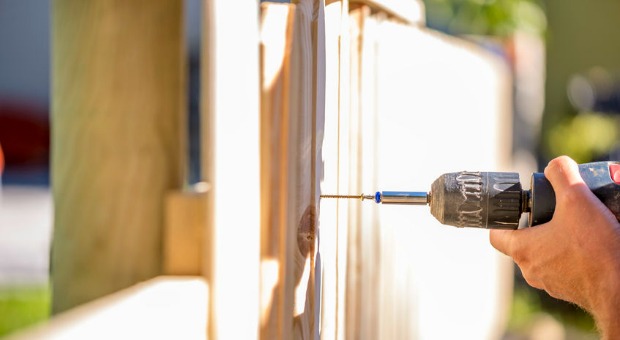There’s an old saying about good fences making good neighbors.
Until Donald Trump entered the White House, borders, which can be described as the ultimate fence of sorts, were not regarded as very important for our nation’s well-being by the progressive Obama administration. Now that old saying makes sense again.
So in today’s article, I’ll tell you a thing or two about how to build the perfect privacy fence.
Just like a nation’s border, building a privacy fence on your property is useful for a number of reasons. The most important one, which depends very much on where you live, is the fact that a properly built fence will increase your safety, security and privacy.
Of course, I am not talking about those nice white picket fences; those are mostly about aesthetics. A privacy fence will keep your children and pets safely enclosed and it will eliminate sight lines beyond your property.
According to various statistics, security and privacy are among the most common reasons for which Americans go home shopping.
The type of fence you have installed around your property limits plays a key role in both privacy and security, together with improving your home’s exterior design. Whether you’re using wood, wrought iron, or chain link, a properly installed fence will provide you with the true sense of home security and ownership we all desire.
Find out more on how to improve your layered home defense to survive disaster!
And once you understand the basics of installation techniques and the materials required, you’ll see that DIY-ing a privacy fence can be a fun activity and fairly easy to accomplish.
Here are some important issues to consider before starting building your fence.
Why are You Building a Fence?
Decide on the height before getting knee-deep into the project.
A normal privacy fence is ~6 feet high (or more). Determining the fence height in the early stages of the project is pretty important, as it will influence various other things like post-hole depth and things of that matter.
What Type/Style of Fence are You Looking For?
Prior to DIYing your fence, make sure you have an accurate understanding of the whereabouts of your property lines. Talk to your neighbors and check your property file to make absolutely sure the fence is on your property.
Check with your local utility companies before you start excavating (if that’s the case) for underground utility mains which may be located on your property. Also check zoning laws and, if required, apply for a building permit before proceeding with the job.
Then what materials/design will blend best with the architecture/landscaping of your home?
There are different fence styles and different fence panels to choose from, which may differ in the fine details, but basically there are 3 main prefabricated fence panel styles available:
- Solid – mostly used for containment fencing as they provide complete privacy and they’re mostly used between property lines and for surrounding swimming pools and the like. These fences are usually 5-6 feet tall and they use closely spaced pickets.
- Spaced Picket – popular for keeping pets or children (some may argue that’s the same thing) in, and/or for defining boundaries.
- Shadowbox – a mix of the two
For our intents and purposes, we’ll concentrate on the solid variety, because the name of the game in today’s article is privacy.
The PVC Fence
If you’re looking for the cheapest way to fence in your property, PVC is hands down the best option.
Even if PVC is not as sturdy as wood, it will last you forever without requiring any type of “servicing” and as far as privacy goes, PVC fences are just as impenetrable as wood fences.
The Vinyl Fence
A more high-tech option is vinyl fencing. According to some manufacturers, vinyl fences are 5 times stronger than comparable wood fences and 4 times more flexible.
The caveat is that vinyl is kind of elite price-wise, but it will resist indefinitely to elements and even paint (read graffiti). All you have to do is to soap it up and put the hose to it and it will look as good as new in a jiffy.
The Bamboo Fence
And there’s bamboo, which is another type of wooden fence but with a more sophisticated touch, as bamboo is a relatively exotic type of wood. Other than being exotic, a bamboo fence is just like any other wooden fence; it just looks more interesting.
However, considering “regular” wood’s versatility and availability, most folks will go for an old-school wooden fence, due to its low-cost maintenance and building. You can also buy prefabricated wood fence panels, which will provide you with more flexibility and greater control in terms of quality (material wise), not to mention that wood is way more aesthetically pleasing compared to PVC for example.
The Wooden Fence
The most popular fencing material across America is wood. Wood fences are not very expensive compared to, let’s say, aluminum fencing. Also, wood gives you a welcoming and warm feeling, together with the sense of privacy wood fencing provides.
A wooden fence can easily be built to last forever, depending on what type of wood you choose. The quality of your fence can be compared with hardwood floors. There’s cheap stuff and more expensive stuff, woods that are better than others, and so on and so forth.
Video first seen on MyFixitUpLife show.
The most common species of wood used in privacy fences are fir, spruce, cedar, pine, cypress and redwood (always go for heartwood instead of sapwood, the former is older, has fewer knots and it will last for longer).
Keep in mind that if you’re choosing the wrong wood, your fence might only last you for 5 years before rot sets in. If you’re going for a high quality wood and you treat it well, a wood fence will last you for more than 20 years. Chemically treated woods are arguably the best option.
How to Build a Privacy Fence
First of all, you’ll have to stake the corner locations and place stakes at the corners, approximately where you wish your fence to go. In the next step, you’ll have to square the corners by tying a string around the stakes then running it between the respective stakes.
Once you’ve squared your corners, stake the middle posts, then dig the holes (step 4) at the locations you’ve staked.
As a general rule of thumb, keep in mind you’ll have to bury the posts at least 33 percent as deep as they’re tall. Then place your posts, get them aligned, then use a post leveler to make sure they’re straight and the corners are still square.
Remember to put 3-4’’ of gravel at the bottom of each hole then pour the concrete footing (instant concrete is best). Then fill in with dirt once the concrete bed has set.
You can add a mason’s line at the top of the post from one post to another at equal height above the ground, thus keeping the height of your fence equal along the way.
Now it’s time to add your support boards and, in the final step, the privacy boards. Remember to treat the boards for increasing the longevity of your fence by painting them or applying a weatherproof finish.
Video first seen on Brandon & Meredith.
If you’ll have to build a wooden fence on a slope, check out this video.
Video first seen on DIY Landscaping.
And here’s a wooden fence with metal posts that will last you forever. You may have to change the privacy boards after a number of years, but the skeleton will last you indefinitely.
Video first seen on CAmericaProjects.com.
Tips and Tricks on Building Fences
- Let your wooden fence set before you seal it, as it’s very important that you allow it to dry out. If you try to preserve the wood by staining/painting it ahead of time, the substance will probably not be absorbed by the wood if it’s not dried properly. Remember that painting is required every few years if you care about the longevity of your fence.
- A common mistake when building fences is failing to anchor down posts. A fence is only as strong as its posts – that’s an axiom – hence posts are essential for a solid fence and also pretty expensive. You must take your time and install the fence posts nice and properly.
- Another mistake is improper gate placement or size. Gates must be placed out of the path of erosion, in well drained areas. Traffic must be taken into consideration, obviously. Proper gate size is equally important. The gate gets the most wear and tear, so remember to build it using high quality materials, including solid and properly sized hinges. Also the posts supporting the gate must be set much deeper than regular ones and you must add more cement around them.
Interested in keeping you and your family safe? Click the banner below for more!








































































While a big fence may be nice it is a flag to those who want what is not theirs that there is something worth protecting. While family is the most important thing to protect, many criminals don’t see it that way and a fence says there is something in there that I want.
I prefer a living fence made of tall, spiky bushes and trees to reduce visibility into my business.
What you have proposed applies to an suburban location. I am about to purchase a 46 acre ranch in a rural area with an existing 4 board fence on all sides, and I am very focused on security. I do believe that there is great potential for substantial civil unrest at some point. My intent is not to look like a fortress, yet achieve a high level of real security. I have designed an entry gate the is attractive but that will resist a small truck if need be. I intend to add a loose wire mesh up to the second board to force intruders up high where I can see them, add motion detection on 4 sides with a silent alarm in the main house and infrared camera’s that cover the entire property monitored at a central location. Is there anything else I can do, or is some of what I’m doing not advisable? Appreciate any input.
For large acreage, create easy pathways so that when they intrude, you will know where they likely are (least resistance). I prefer trees and bushes that resist attempts to penetrate, Locust trees, Mesquite (other issues with mesquite), Horse Apple, spiny trees/bushes with tough wood – roses, Evergreen and Himalayan blackberries depending on climate and how much maintenance you intend. Wire can be embedded when they are young. Yes, this is a long term effort, but with nothing that says, “here lies value”
Owen: I only thought of landscaping as something to keep clear for line of sight. I never thought of using it in the way you suggest. I will definitely us it. I thank you for taking the time to respond. Very helpful.
We are all in it together